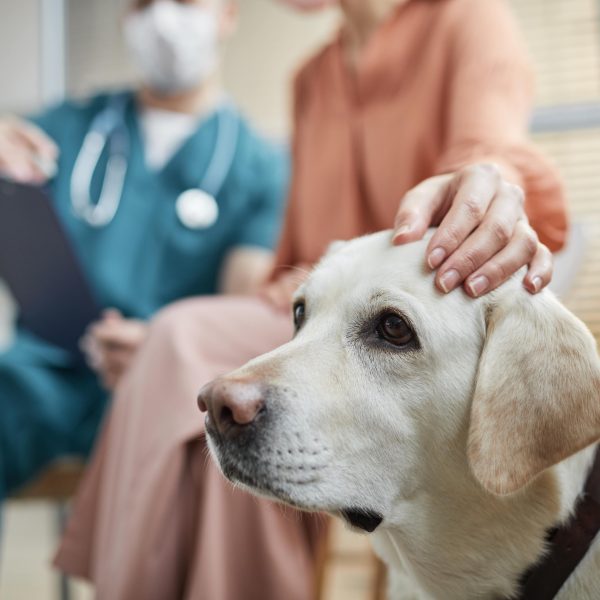What to Know About Laryngeal Paralysis in Dogs

Laryngeal paralysis in dogs is a serious condition that affects the muscles responsible for the larynx, or “voice box.” Laryngeal paralysis can lead to life-threatening symptoms if left untreated. Here’s what to know about laryngeal paralysis in dogs:
What is Laryngeal Paralysis in Dogs?
Like humans, dogs have a larynx too. Sometimes called a “voice box”, this tube-like structure sits at the top of the windpipe, or trachea. When air passes by the larynx, sound is produced. The larynx also works in tandem with the flap of cartilage (epiglottis) that covers the airway during swallowing.
This helps keep food out of the trachea. If a dog experiences laryngeal paralysis, it means the muscles that open the airway stop functioning properly. When this happens, the larynx stops opening and closing normally.
Symptoms of Laryngeal Paralysis in Dogs
If a dog has laryngeal paralysis, it will most likely begin with mild symptoms. However, the symptoms will grow worse over time. The first sign is a dog will start exhibiting increased panting. Laryngeal paralysis can cause dogs to be more susceptible to overheating in warm environments because they have a much harder time cooling themselves with panting.
Overheating and not being able to regulate their body temperature can lead to respiratory distress, heatstroke, and, in severe circumstances, death. Other symptoms of laryngeal paralysis may include:
- Changes in their vocalizations
- Gagging or coughing when drinking and eating
- Trouble breathing
- Swelling in their face
- Collapsing
- Anxiety
- Changes in exercise stamina
- Lethargy
- Changes in their gums, which may turn dark red or blue
These are symptoms you should never ignore in your dog. If you notice any of these symptoms, call your vet as soon as possible. Quick action is necessary.
What Causes Laryngeal Paralysis in Dogs?
Laryngeal paralysis may be caused by degenerative diseases of the nerves and muscles of the larynx, but it’s more often non-hereditary. It can also be a symptom of a more serious neurologic disease called Geriatric Onset Laryngeal Paralysis Polyneuropathy, or GLOPP.
Nerve damage impacting the larynx can cause laryngeal paralysis, but this isn’t as common. This nerve damage is often caused by trauma to the area from cancer, dog bites, or other deep wounds.
How to Diagnose Laryngeal Paralysis in Dogs
If your dog has laryngeal paralysis, your dog may need to be sedated for your vet to see the larynx as well as observe the cartilage and muscles when they open and close. A healthy larynx will easily open and close during one breath. If a dog has laryngeal paralysis, the larynx presents in a semi-open position and will not move.
If laryngeal paralysis is suspected, there may be some diagnostic testing involved. This typically includes blood work, testing of the thyroid function, as well as X-rays or radiographs of the neck and chest areas.
Radiographs can be helpful when diagnosing other causes of coughing or to determine other side effects of laryngeal paralysis. These side effects may include aspiration pneumonia. This infection is caused by food or debris that may be unintentionally breathed into the dog’s lungs.
How to Treat Laryngeal Paralysis in Dogs
There are a few things that can be done to treat laryngeal paralysis and manage symptoms:
Laryngeal Tie-Back Surgery
Surgery is necessary in order to treat laryngeal paralysis. During surgery, permanent sutures hold half of the larynx open, which allows air to pass through more easily. This procedure is called a Unilateral Arytenoid Lateralization (UAL) or laryngeal tie-back surgery.
Reduce Anxiety
If surgery cannot be performed immediately, there are some ways to help your dog find some comfort. Managing your dog’s anxiety is important since dogs tend to breathe heavier when anxious.
Prevent Overheating
Try to keep your dog cool and in a well-ventilated environment. This is a useful summer safety tip for all dogs but extra important in cases of laryngeal paralysis
Switch to a Harness Instead of a Collar
It’s also important to limit activity and avoid collars around the neck. This is just one of the reasons a dog harness versus a collar might be better because it keeps pressure off of the larynx
Intubation and IVs
If respiratory distress occurs, your dog may be intubated. This tube will help get vital oxygen to the lungs. Intravenous (IV) fluids can be helpful in lowering your dog’s body temperature.
Is Laryngeal Paralysis Fatal in Dogs?
If a dog encounters complications of laryngeal paralysis, it can be fatal. Any dog should be closely monitored for signs of respiratory distress and turn to the vet as soon as possible if any signs develop.
This is an overview of what to know about laryngeal paralysis in dogs. Thankfully, there are steps you can take to help your dog remain comfortable in the meantime. Quick and prompt treatment is key to managing this condition and improving your dog’s quality of life!
